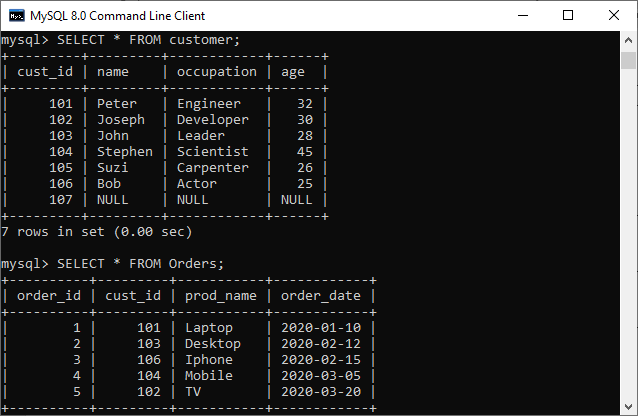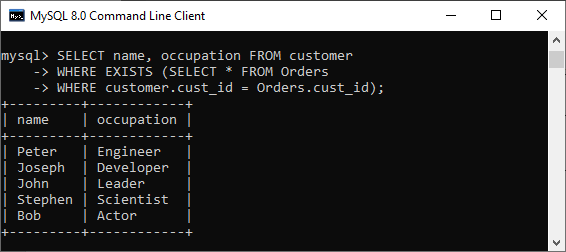IN vs. EXISTSThis article explains the complete overview of IN and EXISTS clause. It is one of the most common questions asked by developers who write SQL queries to filter for specific values. The main difference between them is that IN selects a list of matching values, whereas EXISTS returns the Boolean value TRUE or FALSE. Before making the comparison, we will first know these SQL clauses. 
IN OperatorThe IN operator is used to retrieves results when the specified value matches any value in a set of values or is returned by a subquery. This operator allows us to specify multiple values along with the WHERE clause. It reduces the use of multiple OR conditions in SELECT, INSERT, UPDATE, and DELETE queries; that's why it is also called the shorthand for multiple OR conditions. In this operator, the inner query executes first, and the result obtained is used by the outer query to display the output. It should be remembered that the inner query is executed only once. The IN operator has the following syntax: Let us take an example to understand this operator. Suppose we have a table named customer that contains the following data: 
If we want to get all customer details whose occupation is either doctor, engineer, or scientist, then we can use the statement as follows: Here is the output: 
EXISTS OperatorEXISTS is a Boolean operator which checks the subquery result and returns an either TRUE or FALSE value. It is used in combination with subquery and checks whether a row is returned through this subquery or not. This operator returns TRUE if the subquery returns single or multiple records. Otherwise, it gives a FALSE result when no records are returned. When the EXISTS operator detects the first true event, it automatically terminates for further processing. This feature enhances the query's efficiency. We can use the EXISTS operator with SELECT, UPDATE, DELETE, and INSERT statements. The following is the syntax of EXISTS operator: Let us take an example to understand this operator. Suppose we have a table named customer and order containing the following data: 
If we want to get all customer names and occupation who has placed at least one order, then we can use the statement as follows: Here is the output: 
Key differences between IN and EXISTS OperatorThe following points explain the main differences between IN and EXISTS clause:
IN vs. EXISTS Comparison ChartThe following comparison chart explains their main differences in a quick manner:
ConclusionIn this article, we have made a comparison between IN and EXISTS operators. Here, we conclude that both clauses work for the same purpose, but their internal working is different. In other words, they differ in their logical working. We can select any of them according to our requirement, but if we have a table that contains several records (large data), it is better to use EXISTS rather than IN operator.
Next TopicGROUP BY vs. ORDER BY
|
 For Videos Join Our Youtube Channel: Join Now
For Videos Join Our Youtube Channel: Join Now
Feedback
- Send your Feedback to [email protected]
Help Others, Please Share









